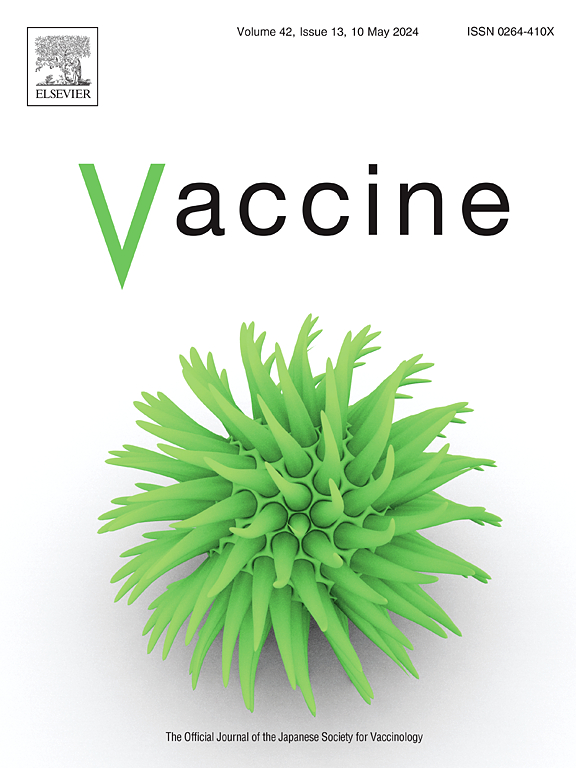A multifaceted, targeted intervention to improve human papillomavirus vaccination rates in general practice: A pragmatic cluster-randomized controlled trial
IF 4.5
3区 医学
Q2 IMMUNOLOGY
引用次数: 0
Abstract
Background
Human papillomavirus (HPV) vaccination rates are low in Switzerland. The aim of the study was to test a pragmatic multifaceted targeted intervention among general practitioners (GPs) to increase HPV vaccination (HPVv) rates in general practice.
Methods
In this cluster-randomized controlled trial, two equally sized groups of GPs each received an educational session on vaccination in general and on the national vaccination schedule. Treatment group GPs additionally received detailed information about HPV, information leaflets, and were instructed on HPV announcement training as an approach to recommend HPVv. Primary outcome was the number of first HPVv doses administered per GP up to six months after study start (T6). Secondary outcomes were first HPVv dose counts at T3 and T12 and the GPs' changes in attitudes and knowledge regarding HPVv from baseline to T6. Outcomes were analysed using mixed-effects Poisson and logistic regression models.
Results
A total of N = 56 practices with n = 72 GPs were randomized. GPs administered a total of 5329 vaccine doses including 195 HPVv doses. The intervention had no effect on the primary outcome (adjusted rate ratio [95 % CI]: 1.55 [0.72–3.37]), and none of the secondary HPVv count outcomes reached statistical significance. The treatment group showed significantly higher odds of changing attitudes towards HPVv (adjusted odds ratio [95 % CI]: 17.89 [3.36–95.23]). We found no difference in knowledge gain between the groups.
Conclusion
The multifaceted intervention improved attitudes towards HPVv but failed to increase HPVv rates or knowledge. Insights from the study can help inform the development of future HPVv interventions.
Trial registration
ISRCTN 55473884, first registered on 04/06/2021.
在一般实践中提高人乳头瘤病毒疫苗接种率的多方面、有针对性的干预:一项实用的集群随机对照试验
背景:人乳头瘤病毒(HPV)疫苗接种率在瑞士很低。本研究的目的是在全科医生(gp)中测试一种实用的多方面目标干预,以提高全科医生的HPV疫苗接种率(HPVv)。方法在本随机对照试验中,两组同等规模的全科医生分别接受了关于一般疫苗接种和国家疫苗接种计划的教育。治疗组全科医生还收到了关于HPV的详细信息、信息传单,并接受了HPV宣讲培训的指导,作为推荐HPV的方法。主要结局是研究开始后6个月内每个GP首次接种HPVv剂量的数量(T6)。次要结果是T3和T12时的首次hpv剂量计数以及gp从基线到T6时对hpv的态度和知识的变化。使用混合效应泊松和逻辑回归模型分析结果。结果共N = 56个执业,N = 72个gp被随机化。全科医生共接种了5329剂疫苗,包括195剂人乳头瘤病毒疫苗。干预对主要结局无影响(校正率比[95% CI]: 1.55[0.72-3.37]),次要HPVv计数结局均无统计学意义。治疗组对HPVv态度改变的几率显著高于对照组(调整比值比[95% CI]: 17.89[3.36-95.23])。我们发现两组之间在知识获取方面没有差别。结论多方面的干预改善了对hpv的态度,但未能提高hpv的发病率和知识。这项研究的见解有助于为未来hpv干预措施的发展提供信息。试验注册号:isrctn 55473884,于2021年6月4日首次注册。
本文章由计算机程序翻译,如有差异,请以英文原文为准。
求助全文
约1分钟内获得全文
求助全文
来源期刊

Vaccine
医学-免疫学
CiteScore
8.70
自引率
5.50%
发文量
992
审稿时长
131 days
期刊介绍:
Vaccine is unique in publishing the highest quality science across all disciplines relevant to the field of vaccinology - all original article submissions across basic and clinical research, vaccine manufacturing, history, public policy, behavioral science and ethics, social sciences, safety, and many other related areas are welcomed. The submission categories as given in the Guide for Authors indicate where we receive the most papers. Papers outside these major areas are also welcome and authors are encouraged to contact us with specific questions.
 求助内容:
求助内容: 应助结果提醒方式:
应助结果提醒方式:


